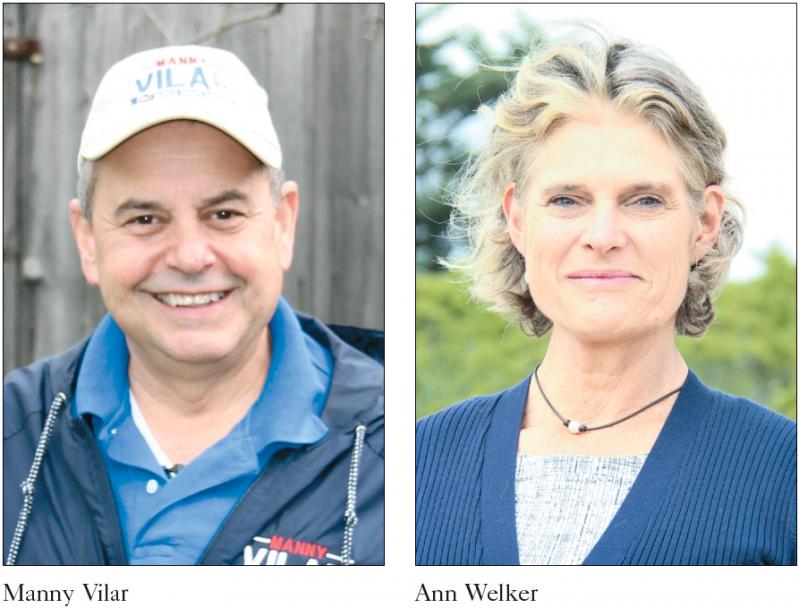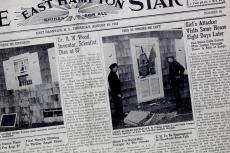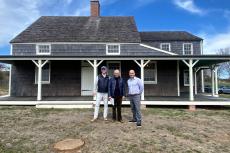Monday’s debate between candidates for the Suffolk County Legislature’s Second District, hosted by the League of Women Voters of the Hamptons, Shelter Island, and the North Fork, was a sedate discussion of issues including wastewater management, renewable energy, housing, traffic, and migrants.
Manny Vilar, a Springs resident, the chairman of the East Hampton Town Republican Committee, and a retired state parks police officer, is the Republican candidate. His Democratic opponent is Ann Welker, a Southampton Town trustee. They are vying to succeed Legislator Bridget Fleming, who is not seeking re-election. Ms. Fleming, a Democrat, has endorsed Ms. Welker’s campaign.
Asked by the moderator, the league’s Judi Roth, to identify the three most critical issues facing the county, Ms. Welker called wastewater the most important, and pledged to work to advance the Water Quality Restoration Act, which the Legislature’s Republican majority voted in July not to put on the Nov. 7 ballot. Voters, had they been able to weigh in, would have decided whether the county sales tax should be increased by one-eighth of a cent to create a Water Quality Restoration Fund. The act, Ms. Welker said, would “fund a continuing revenue stream for upgrades to our septic systems and sewering, where appropriate.”
Renewable energy, as well, is “vitally important,” and the Legislature should build on solar and wind infrastructure, she said. Third, “we are canaries in the coal mine on the East End in that sea level rise and climate change are critically important conversations.” She called East Hampton Town a leader in addressing climate change. “At the county level is a Suffolk County Coastal Resiliency Initiative,” which she said will identify county-owned shorefront parcels where climate change can be mitigated “with nature-based solutions rather than shore-hardening structures, which exacerbate erosion.”
Mr. Vilar agreed that “septic waste management is a tremendous problem” and that “we have to approve that resolution in the County Legislature.” The county, he said, should also look to use money from the federal Bipartisan Infrastructure Law, which makes available $2 billion to address emerging contaminants in drinking water.
“We also have to deal with overall infrastructure,” Mr. Vilar said. “County Road 39 is a mess. . . . We have an affordability problem” that extends beyond housing to workspaces as well. “We also need to understand that New York State is facing an $8 billion deficit next year,” which will adversely impact the county’s budget. He criticized the county’s existing leadership for the costly 2022 cyberattack “that could have been a nominal fix for a few hundred thousand” dollars.
“We have a very narrow, tunnel-vision view of renewable energy,” Mr. Vilar said, adding that sources other than offshore wind, such as hydrogen, should be developed toward “the ultimate elimination of fossil fuels.” Commercial fishermen oppose offshore wind, he said. “We need to have a real broad-based, wholehearted, full-throated look at all our renewable energies, both current and up and coming, so we can develop a plan moving forward for our entire community.”
“We need to transition away from fossil fuels in light of climate change and particularly sea level rise,” Ms. Welker said. “So I am a strong proponent for wind farms,” provided they are properly placed. She said commercial fishermen should be compensated if wind farms disrupt their ability to work.
But future development of offshore wind may be in jeopardy, Mr. Vilar said. “We know electric rates on Long Island are oppressive. We need to ensure that we’re investing in renewable energies that are not going to add to the economic degradation of our communities.”
On affordable housing, Mr. Vilar said, “We need to work as a county to create an economic environment where we can create affordable workspaces, we can create jobs that are good-paying jobs, and have a highly educated community.” None of his six children can afford to live here, he said. “We need to really invest in our communities and work with our town on zoning. We need to work with our local business community and need to work with our developers to try and create these work areas that can bring high-paying jobs” commensurate to the second-home economy, “which is what has driven up the cost.”
Ms. Welker pointed to the state’s 72-h transfer program, under which the county transfers built-upon and vacant parcels to municipalities for construction and reconstruction of affordable housing. “There will be a list compiled of these properties when they become available,” she said, “and towns and not-for-profits will become informed about them so that they can then make those purchases for work-force housing.”
She also reiterated the need for the Water Quality Restoration Act, and said the county should work to upgrade septic systems to accommodate housing in accessory structures. “It’s critically important that we address our work-force housing in whatever way possible. Working with the county and the towns and accessing state and federal funding is critically important so we can keep our young people and our seniors in the community.”
Mr. Vilar agreed that encouraging housing in accessory apartments is an important near-term solution, “but the reality is we need an economic development of good-paying, high-paying jobs.”
Regarding traffic, Mr. Vilar called for “a complete redesign and reinvestment in County Road 39” and investment in affordable workspace that is easily accessible to the Long Island Rail Road. “Possibly, we should be thinking about creating an East End Transportation Authority and taking over the assets” of the L.I.R.R.
Ms. Welker also spoke of the L.I.R.R., suggesting that sidings could be refurbished allowing a two-car “scoot train” to run multiple times per day, perhaps between Hampton Bays and Bridgehampton. The South Fork Commuter Connection has been very effective, she said, “however, it’s not a one-stop shop. We need more.” She mentioned the Suffolk Transit On-Demand service along Noyac Road from Sag Harbor to Southampton Village as a program that might be expanded.
Asked about combating the sale and distribution of illicit drugs, Ms. Welker said there are multiple vacancies in the county’s deputy sheriff’s department that must be filled. Police departments must be fully funded and trained, she said, and she called for more Spanish-speaking police officers.
Mr. Vilar countered that “the problem is not a Hispanic problem, it’s a problem for everybody.” The problem is multifaceted, he said, blaming a relaxation of state laws, bail reform, decriminalization of marijuana, and the “defund the police” movement, which he said Ms. Fleming supported and which “dramatically reduced funding for training for police officers nationwide.”
Ms. Welker said Mr. Vilar’s assertion about Ms. Fleming’s support for defunding police “is simply not true,” and added that she was not targeting the Latino community. “I was merely saying that if there’s a significant Hispanic population in Suffolk County, having police that speak Spanish on our force is an important communication tool.”
The Second District comprises East Hampton, Southampton, and Shelter Island Towns as well as three election districts in East Moriches and Eastport, in Brookhaven Town.
Election Day is Nov. 7. Early voting takes place from Oct. 28 through Nov. 5.




